#i kind of really love how the different thicknesses of resin in parts already adds a lot of depth
Text
On the one hand, dyeing dollbei jun kind of got me over my fear of screwing up unstringing him (i did have to ask my husband for help with unstringing the arms because i couldn’t get it out far enough to wedge something there to remove the hook, but i also have some tendonitis/ cartilage issues in my hands and wrists anyway) and just going for it.
On the other, the color isn’t really what I was going for (yes i know i should check what things look like other than on my computer. no i didn’t do that. shame on me xD).
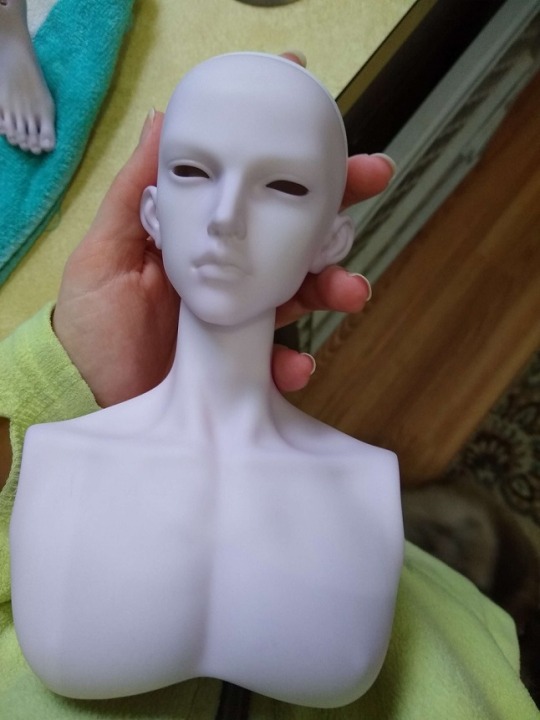

Pretty color! Not what I was aiming for :/ The formula i used looked more brown on my computer screen, but this matches how the swatch looks on my phone pretty well (though i did adjust the formula by adding an additional 3/4 tsp of the brown dyes)
So now I have to try to decide how I want to proceed. I could keep it as is, or try to blush it to get it closer to what i was aiming for--either with pastels or the airbrush-- but i know that will chip over time and honestly dyeing feels easier at this point. Color theory says combining yellow with purple should neutralise the color, but i don’t want it more grey, so I’m not sure if I want to try doing a quick dye bath with plain sandstone or another combination of sandstone and chocolate or some other combination (I think in paint mixing for example you’d add a bit of red as well as yellow to keep the combination from going too grey). or removing it and starting over with a base of the sandstone and chocolate and adding a touch of the purple or sapphire instead of using a formula that calls for more of the latter as a starting point.
#quill's bjd adventures#dollbei jun#not pictured: all the bits including the doll dicks which got used to test times mostly xD#except the first one where i went oh. oh no this is PURPLE and tried to course correct lol#was aiming for a cool toned skin tone which clearly this isn't and i'm ok with it being just this side of inhuman#but this is a little too far on that side for what i wanted. also very purple which like..duh it used royal purple as a starting point#but in my defense most of the blue formulas ALSO use purple as a base so i assumed it was cool toned and leaned blue#i kind of really love how the different thicknesses of resin in parts already adds a lot of depth#i feel like i should've expected that but i didn't and i love it#i was using the mist dyemore color formula so if anyone's looking for a pretty lavender grey color that's your color xD
0 notes
Text
‘It Will Be Beautiful Again’: How California’s Redwood Forest Is Recovering After Last Year’s Wildfires
— Gabrielle Canon in Big Basin | Saturday 5 June 2021 | Guardian USA
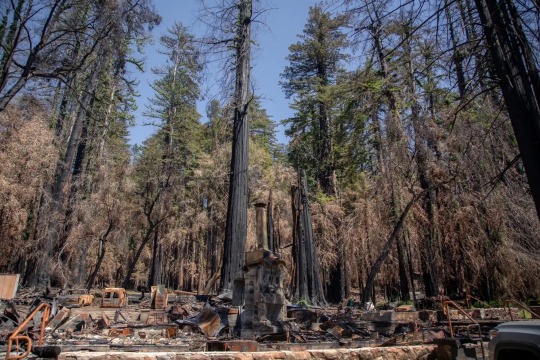
The headquarters at Big Basin Redwoods state park was destroyed by the CSU Complex fire last August. Photograph: Gabrielle Canon/The Guardian
Big Basin state park, scorched last August in the CZU Complex fire, is showing signs of rebirth in its majestic redwood trees
There are spots inside Big Basin Redwoods state park that appear to be frozen in time.
Roughly 10 months after the CZU Complex fire burned 97% of California’s oldest park, some trees still smoke and smolder. An open champagne bottle sits untouched atop a scorched picnic table alongside cooking utensils that are melted and singed together. Contents from a toppled cooler, left agape, have begun to blend into the forest duff. The skeletons of burnt cars and trucks are still parked in front of once-iconic headquarters, now reduced to rubble.
But, amid the wreckage, there are also signs of rebirth. Wildflowers are growing over charred debris. Blackened trees have sprung vibrant green sprouts. Birdsongs and hammering woodpeckers accent the hum of state-run construction crews working to ready the beloved park for a new chapter in its history.
“The biggest loss is the human side. This park is not going to be the same place that I saw as a little girl,” says Joanne Kerbavaz, a senior environmental scientist with California state parks on a tour of the park this week. “But as an ecologist, part of me is thrilled by the opportunity to watch how the redwood forest recovers.”
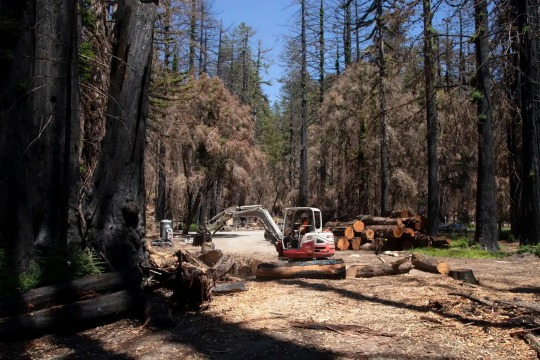
Crews work to clear dead trees from within the burn scar inside Big Basin Redwoods state park. Photograph: Gabrielle Canon/The Guardian
Big Basin is home to roughly 4,400 acres (1,780 hectares) of old-growth redwood trees, majestic giants that are among the oldest living things on Earth. Their lifespan can stretch beyond 2,000 years and they have adapted to survive and thrive in California’s mediterranean fire-prone climate.
After being heavily logged in the 1800s, the Sempervirens Fund, a non-profit group, formed to protect the trees in 1900 and two years later Big Basin was created – California’s first state park – so millions of people from around the world could travel to marvel at them.
Just like the redwoods, Big Basin, too, will survive this fire. But when it reopens, it will look different. Along with new structures and facilities, many of the park’s 80 miles (128km) of trails will have to be newly carved into the rewilded landscape with new bridges, steps and railings built to support them.
“We have the opportunity to reimagine how to interact with this park,” Kerbavaz says. There are discussions around how to rebuild the park back, to be even more accessible for generations to come. Attitudes have changed over the last 119 years and the park, like others across the US, has exploded in popularity. The climate is also changing, adding new pressures and threats to the ecosystems.
“There is going to be a very robust planning process,” she adds, acknowledging the range of views about how old-growth forests should be protected and enjoyed into the future. “It is going to be open and inclusive and that means it is going to take a while to make some of the calls.”

Flames from the wildfire burned through the thick bark on some trees, singeing through to the wood underneath. Photograph: Gabrielle Canon/The Guardian
Most agree that increasing resilience should be a priority. “The near-complete destruction of the buildings and facilities at Big Basin illustrates just how ill-adapted they were to fire,” the Sempervirens Fund wrote on its website in February. “If you love Big Basin, please consider this: rebuilding Big Basin can pioneer a new model for California’s state parks, just as Big Basin accomplished more than a century ago.”
Before rebuilding begins, though, there’s a considerable amount left to be cleared.
Along with toxic debris and crumpled buildings that need to be cleared, hazardous trees are being assessed for removal. The process of identifying which trees are dead or dying is delicate and layered. Five agencies have already weighed in, and perspectives on what should stay and what should be pulled out do not always align.
Several beloved old-growth trees have already been saved by park officials, including the famous Auto Tree, which is the most photographed Redwood in Big Basin. Estimated to be more than 1,500 years old, generations of visitors have climbed into its large opening created by fires in the past. The pictures go back to the park’s beginnings. There are photos of horses and buggies backed in and of ranger trucks in the 1970s.

large redwood tree, which fell decades ago, was a favorite stop in the old-growth grove in Big Basin. Flames swept over the base of the giant tree and half of the sign introducing it. Photograph: Gabrielle Canon/The Guardian
“There was a mark to cut down the tree,” Kerbavaz says, “but I said, hey, this is one we really don’t want to lose.” So far, it’s showing signs of survival, with small green offshoots at the base and sparse growth in the canopy, and there’s hope that it has enough structural support to stay standing.
The process of deciding what will stay and what will go has been thorough and arduous. First, CalFire came through and cleared a path for crews. CalTrans examined what might become hazardous to the roads. Santa Cruz county officials assessed the areas managed by the municipality, and then PG&E did their analysis. California’s Department of Emergency Services is currently in the park and still finding trees to mark for removal.
Trees are painted with a series of letters and numbers, meant to catalog them and indicate to crews that they should be culled. Some also have flags and ties, showing that park officials, who have overseen the process, do not agree.
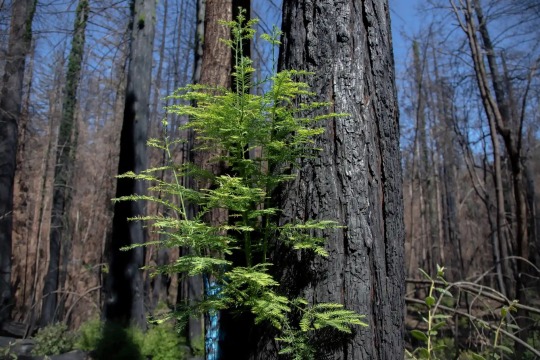
Blackened redwood trees show signs of new growth after the CZU Complex fire burned through 97% of the park. Photograph: Gabrielle Canon/The Guardian
“There is a science and an art,” Kerbavaz says of the process. “I come, of course, from the parks’ perspective, which is we really would like to keep as much as we can”.
Along with tree removal, trails will have to be remade. Most of the wooden infrastructure, including steps, bridges and railings were obliterated in the fire. Some of it was put in place to hold erosive hillsides, which have since crumbled. Other hazards have to be assessed before guests can be welcomed back in. There are pits left from where subterranean roots from more flammable trees, such as Douglas Firs, burned into the earth.
Meanwhile, scientists are utilizing the opportunity to use the burn scar to learn about fire behavior, ecological resilience, and climate change. “We are trying to get baseline data so people can return in maybe 5 or 10 years down the line, and see how it grows and changes into the future,” says vegetation ecologist Alexis Lafever.
“There are so many baby redwood seedlings and they are so cute,” she says. In some areas, she’s encountered hundreds of seedlings. They won’t all survive, but, she adds, “things are growing back. The forest will be fine.”
There are also signals that animals are emerging and returning. Salamanders survived by burrowing under the duff, banana slugs took refuge underground, and birds have reinhabited the burned branches.
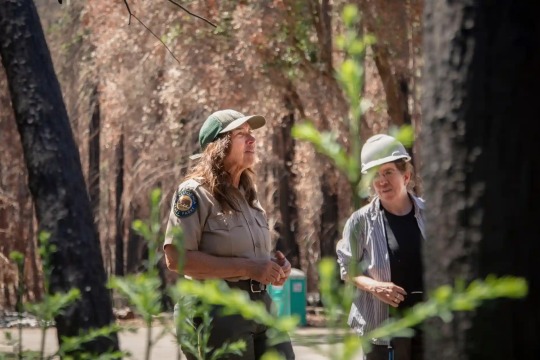
Joanne Kerbavaz, a senior environmental scientist with California state parks, speaks to researchers and students during a tour of the park. Photograph: Gabrielle Canon/The Guardian
“Almost everything that lives here has some strategy for avoiding fire,” Kerbavaz says. “But any kind of disturbance like that, there are some species that are harmed and some species that are favored.”
There are those that thrive after fire. The Knobcone Pine requires temperatures up to 350F (177C) to melt a resin from its cones to sprout seeds. Some woodpeckers prefer dead trees to living ones. But the fire, which burned fast and hot, with flames that licked the canopy 300 feet (91 metres) into the sky and tore through close to 18,000 acres (7,285 hectares) of the park in only 24 hours, did leave devastation in its wake. Current assessments show even with the resiliency of the redwoods, 10% of the trees won’t recover. The damage is also expected to cost nearly $200m.
“Those buildings are gone. That specific experience is gone,” Kerbavaz says. “There’s some of that loss of the big trees that make it such a special forest. But we have opened up places for the next generation of big trees to grow,” she adds. “It will be beautiful again – even if it is not as you remember it”.
0 notes
Text
Wet bottom: a haulout story
Totem cruises the Sea of Cortez; in about three weeks, we haul at the Cabrales shipyard in Puerto Peñasco, a small harbor surrounded by the Sonora desert. Typically, boats can go a few years between haulouts. So why now – didn’t we just do this in Grenada, six or seven months ago? Yes, we did, and had an unpleasant surprise. This is the backstory, and what we’ll do about it in Peñasco.
At the time we hauled out in Grenada Totem had gotten nearly three years out of the bottom paint applied in Thailand. That’s a good lifespan for ablative! We chose Grenada to repaint (a relatively safe hurricane season location, affordable rates, cruiser-friendly boatyards). Not only that, but in Grenada we had an opportunity to do a “proper” bottom job on Totem.
Prior to hauling in Grenada, we put on three bottoms on Totem in ten years, representing at least 11 coats of paints and primers and barrier coast. That’s on top of who knows how many layers we bought the Stevens 47 then called “Don’t Look Back.” Even then the hull wasn’t very smooth; over the years, accumulation of bottom paint became progressively uneven. By sand blasting the bottom back to the original barrier coat over Totem’s gelcoat bottom, we’d be able to start fresh. The crew at Grenada Marine would help us get it done right!
Totem gets hauled at Grenada Marine
Blasted surprise
To take down the old paint, a specific grade of sand is used; it’s mixed with water into a slurry that’s blasted at the bottom. This removes paint without damaging gelcoat or epoxy barrier underneath. Except what we found underneath the paint was a big surprise: there was no barrier coat. There was not even gel coat. Just bare fiberglass hull.
Bare fiberglass: not what we expected under the paint
The crew sandblasting stopped work to inform Jamie. I’d like to say it was to inform me, too, but I was happily internet-ing away with wifi in Grenada Marine’s lovely open-air waterfront restaurant. But this discovery… it wasn’t really good news. It wasn’t what anyone expected. The only thing to do was remove the rest of the paint, evaluate the bottom, and then decide on the next steps.
Why bare fiberglass?
We suspect Totem had a big problem with osmotic blisters somewhere in her history. Os-whaaa? Osmotic blisters are bubbles on the hull caused by a reaction between salts (from absorbed seawater) and styrene (a chemical in the fiberglass resin). This reaction causes pressure which can be great enough to push outwards between the fiberglass hull and gelcoat outer skin, creating a bubble (or, blister).
It can also happen pretty easily deeper than the surface: when fiberglass boats are made, they’re mainly constructed from heavy-duty fiberglass roving. But the outermost layer is usually thinner/lighter, to provide a smoother surface so that the last layer before gelcoat is a gentler transition to a smooth outer hull. Because that’s a thin layer of fiberglass, in bad cases of blistering this layer can be affected too: it can create voids by pushing out in that last, lightweight layer of fiberglass. (Side note: we’re not chemical / material engineers; this is just our understanding!)
Naked hull
We suspect Totem’s problem had sufficiently bad blistering that a prior owner did what’s called a full peel. That’s when all the gelcoat is removed (peeled), and the hull is allowed to dry (hopefully) to resolve a blister problem. The bottom is then rebuilt by adding a new, thin outer layer of fiberglass and a two-part epoxy resin barrier coat over the top of that.
The crew working with us at Grenada Marine murmured approval at the fiberglass hull. Whoever did it had done a nice job, and they appreciated a good layup. The question was: would the fiberglass be wet? Or dry?
It’s a bigger problem
When blasting was finished and we were waiting for Totem to dry from the wet slurry, Jamie was cautiously optimistic that the bottom wasn’t wet. We really hoped it wasn’t, as this signaled the need for more work and more expense. But the crew supporting us, who we had come to trust for knowledge and judgement, looked at Jamie and said – “I know it’s wet.” How? In even that brief waiting period, he pointed out a sheen on the hull’s surface. This was a sticky, shiny film that is a result of the reaction between the salt and styrene. That only happens if there’s moisture in the hull. Subsequent readings on a moisture meter over a period of days confirmed his observation.
Why did it happen?
The crew may have appreciated that fine layup, but we still had a problem. Well-done fiberglass work aside, there were two unknowns in that job which lead to the moisture problem we faced.
First, we don’t know what kind of barrier coat as applied. We can tell it wasn’t a two-part epoxy resin; we’d have seen that layer that when sandblasting. We could hope that that outer layer of glass was correctly done, but we don’t know.
Second, we don’t know if moisture in the hull which caused the blisters had been dried out before the repair was made, or if there was still moisture absorbed in the hull that got covered over. What we had left is a fiberglass bottom without a gelcoat that would shown blistering from remaining moisture, so we can only speculate.
Excavating Totem’s bottom
Somewhere between these missing links of information, Totem’s bottom became a wet hull. Jamie suspects the hull wasn’t wet initially, but has happened over time under our ownership due to the problems with the earlier repairs. Why? Because for our first years of ownership we always floated high on our waterline, and in recent years, Totem has sat relatively low on her lines. OK, OK, we have accumulated trinkets on board and the kids have gotten bigger and there are probably a few more items in lockers than when we moved aboard in May 2018! But these would not add up to the mass required to sink Totem to the point where our stern end has settled down to (and even slightly below) the waterline. Most likely this water weight has slowly accumulated over time.
Now what?
We were reluctant to bury the wet hull under more paint, but had few options. The hull needs time to dry out, Grenada’s humidity and rain makes it a poor choice of location. On the other hand, we had plans to sail for the Pacific coast of Mexico. Where better than the dry desert of Baja, already our anticipated destination for hurricane season? So thin barrier coat and two thin coats of ablative bottom paint were applied: enough to get us to an ideal place for drying out a boat, the low humidity of the Sonora desert. These thin layers are already thinning, which we hope makes the job of going back to bare fiberglass for a proper dry-out an easy one.
Totem will sit on the hardstand in the desert while her crew spends a summer back in the Pacific Northwest. A periodic rinse is good and the rain there is measured in millimeters, so a periodic hose-down to help pull out impurities and styrene will be hired out in our absence. We’ll be back in the back half of October after the Annapolis Boat Show. HOPEFULLY, at that point, the hull will measure dry; then the work to put it back begins. Fairing the hull. Adding multiple coats of two-part epoxy barrier to keep water out. Starting fresh, with new bottom paint.
Grenada Marine
We may have had disappointing news during our haulout at Grenada Marine, but the crew we worked with gets high marks. Part of our decision to haul there was the full-service staff. At other boatyards, you hire in contractors associated with the yard. On one hand, that puts the choice of workers solidly in your hands. On the other, being your own project manager adds risk and time (I’d prefer deal with one point of contact the yard if there are problems, rather than a handful of different contractors). We were allowed to mix DIY work in, which helped us save money on jobs we could do, and everyone who worked on Totem impressed us.
Very happy with the team at Grenada Marine! Just before splashing with a shiny bottom
More on blistering
That’s the story of why we’re hauling out again so soon. Here are a few FAQs about osmotic blistering (and water ingress).
What does it look like?
Osmotic blisters can be the size of a coin, or much bigger – especially if the thinner fiberglass layer is what’s being lifted instead of a bubble of gelcoat.
What do you do if you have blisters?
It’s a question of magnitude: the size, quantity, and depth of blisters as well as the type of hull (cored or solid). Depending on the scope of the problem, they can be dug out – dried – filled, then repainted; if there’s time you can dry the bottom further, and re-barrier coat it.
When blistering is really bad, if you can afford it: peel the (permeable) gel coat, dry out the hull, and start fresh with a new barrier coat. Just, a more effective barrier than was apparently applied to Totem!
How do you dry out?
It’s pretty convenient that we have a low-humidity desert stop ahead. Grenada would have required intervention beyond sitting on the hard to sufficiently dry out. Heat lamps, heat pads, infrared lamps, and other options are available. Glad we can just park in the desert!
How bad can it be?
Osmotic blistering is partly a cosmetic problem of unsightly pox. Mostly, it makes a boat heavier. My dear friend Pam Wall lost 1,500 pounds of water weight absorbed in the hull of her beloved Kandarik, when hauled in Portugual for the better part of a year! This is mainly a practical problem for a boat that now sits lower in the water and may be slower. It can be behind some peskier problems than just making the boat weigh more, too We’ve also heard of dampness being felt on the interior, and potentially causing problems with mold/mildew.
Can the hull integrity be compromised?
Hull thickness, and strength of the layup in the materials, make it less likely. In a cored hull, water ingress can cause more significant problems. If the outer skin is thin, the blister and moisture in it can reach core material. Presumably that’s closed cell, but can still leech and lead to larger areas of delamination. Fortunately this is pretty unusual! Bottom line: it won’t sink your boat.
Further reading
An excellent guide to boat care with good information on the why and how of osmotic blisters, and deep details for DIY fixing (because wow, can this get costly) is Don Casey’s This Old Boat.
Totem and crew are enjoying stops along the inside of Baja on the way north to Puerto Peñasco.
Relaxing at Grenada Marine’s restaurant at the end of the day
from Sailing Totem https://ift.tt/2JjVmM4
via IFTTT
0 notes